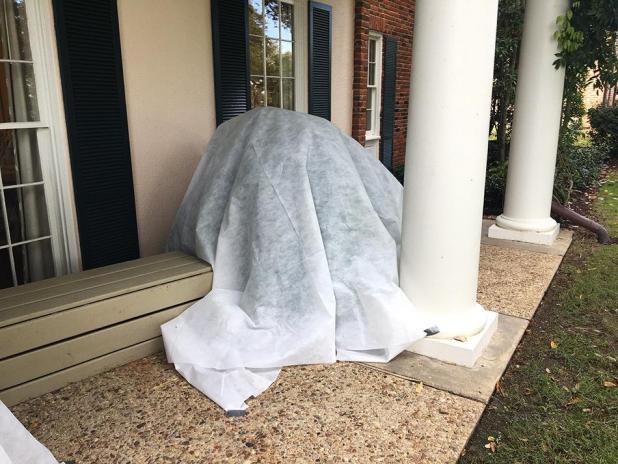
Bring tender container plants under shelter and cover them during hard freezes. Be sure any covering extends to the ground. Remember to remove the covering when the weather warms.
—LSU AgCenter/ Heather Kirk-Ballard photo
Get it Growing: What to do with plants after a freeze
We have had our first hard freeze, in fact we broke low temperature records dating back to 1907. The low temperature reached 24 degrees in Baton Rouge, breaking the lowest temperature in recorded history for this time of year.
I got many calls on what to do to prepare plants for freezes. Let’s recap what should be done and also look at how to care for plants that have suffered freeze damage.
To prepare plants for freezing weather conditions, first turn your attention to tropical and subtropical plants that have tender herbaceous foliage. They will be the most susceptible to damage.
If they can be moved, move them indoors or into a garage. You may choose to move them under a patio and cover them with plastic or sheets all the way to the ground. This helps trap heat under the cover and prevents frost from forming on the leaves. Leave the light on to help generate a very small amount of heat.
Additionally, you should water plants, especially container plants. Water is an insulator, and wet soil will be warmer than dry soil. It is best practice in the fall and winter to mulch landscape plants to help insulate the roots. Use straw or pine straw mulch loosely packed around the base of plants.
Next, you should understand the signs of freeze damage. The signs are pretty evident. Plants will not look the same. Most tropical plants will lose turgidity, become droopy or shriveled and resemble a plant that is lacking water. Addi-tionally, foliage will turn from green to brown or purple. Under an extended hard freeze, you may see plant stems splitting and peeling. If you see this, there will likely be no resurrection.
In extended hard freezes, the water in between and within the cells of the plants will freeze, causing the cells to expand and rupture and resulting in damaged plant tissue. This type of damage is typically irreversible. You will see this most often in tropical plants after a freeze. These include plants like hibiscus, cannas, pentas, vinca, angel’s trumpet, banana trees, gingers, succulents and cassia trees. Think leafy plants.
If you did get caught off guard and your plants suffered freeze damage, you can do some things to help them recover. The amount of damage depends on the severity and duration of the freezing temperatures. If you have light freezes for short periods of time, plants can usually recover. After hard, long freezes, there’s no guarantee.
After the freeze, you should be patient. Do not go straight for the pruners and cut everything back. It takes several days for plants to show us just how damaged they are.
If plants are mushy and slimy, remove this material to prevent fungal infection or disease in the days to come. You may cut out the dead material to clean things up. For woody plants, it’s best to wait until spring. You can check for life on woody plants and perennials by scratching the bark of stems and look for green color underneath. If you find green, you’re in luck. Your plant is still alive.
If you covered plants, remove the covers on warm, sunny days but keep them close by. It will likely freeze several times over the winter. Check weather apps and watch the news periodically. If it is going to warm up for several days, plants that were moved into shelter can be moved back out. They will need plenty of sunlight to photosynthesize and stay healthy. Remember, plants make their own food from energy from the sun.
Caring for plants during freezing weather is a labor of love and can be a great deal of good exercise. You can keep tropical and sub-tropical plants going year-round by taking the proper precautions. Or you can look at it on the bright side: Mother Nature takes care of pruning for us in winter. Tropicals and herbaceous perennials that have grown unruly over the summer got a good trimming. They may flush out again next spring, coming back from their roots.
